

Smart monitors: Samsung M5 and M7 review
Samsung’s M5 and M7 are a monitor and TV in one. They’re the South Korean manufacturer’s response to the need for flexible products and hybrid solutions that marry home office and personal use.
A lot of us have been working from home now for almost a year. I reckon the way we work will continue to look a bit different in post-Covid times. One that will require some rethinking at home to accommodate hybrid forms of working. In other words, our homes will also become our workplaces. Since we don’t all live in palaces, Samsung has helped with space-saving by delivering a monitor and TV in one in the form of the M5 and M7.
Comparing the monitors
Samsung gave me an M5 and M7 to test out for this review. The differences are obvious. The M7 features a 32-inch display with UHD resolution, and it delivers a bit more in terms of ports. Here’s a direct comparison of the M5 and M7:
| Properties | M5 | M7 |
|---|---|---|
| Display | 27-inch VA panel with 1920×1080 | 32-inch VA panel with 3840×2160 resolution |
| Refresh rate | 60 Hz | 60 Hz |
| Response time (grey to grey) | 8 ms | 8 ms |
| Max. brightness | 250 Nits | 250 Nits |
| Contrast ratio | 3000:1 | 3000:1 |
| Viewing angle stability | 178°(H)/178°(V) | 178°(H)/178°(V) |
| Ports | 2× HDMI 2.0, 2× USB 2.0 type A
Bluetooth 4.2 and WiFi5 and Airplay | 2× HDMI 2.0, 3× USB 2.0 type A and 1× USB type C version 3.1 Gen2 with 65 Watt
Bluetooth 4.2, WiFi5 and Airplay 2 |
| Speakers | Yes | Yes |
| Additional features | HDR10, remote control, Bixby, Samsung Wireless DeX, PC remote access | HDR10, remote control, Bixby, Samsung Wireless DeX,PC remote access |
| Dimensions with stand (W×H×D) | 615×455×193 millimetres | 716×517×193 millimetres |
PC gamers won’t have much use for the M5 or the M7. The 8 ms response time and 60 Hz refresh rate might be OK for console players, but they’re too slow for PC gamers who rely on a mouse and keyboard. Then again, not every monitor has to be aimed at gamers. If you’re a couch potato, the lack of a TV tuner could be a turn off, but a set-up box usually does this job anyway. That or you’re like me and you don’t have a traditional TV any more. Either way, the monitors are smart, and thanks to the Tizen operating system, they deliver more than Samsung’s traditional TVs.
Connectivity
You can either connect the smart monitor via the traditional route of HDMI cable or by connecting wirelessly. This works with Windows and MacOS, with Samsung smartphones via DeX and with iPhones and iPads thanks to Airplay 2. Tap View is also included. It lets you mirror a Samsung smartphone screen by tapping it on the monitor. The various connection options are generally easy to use and quick to set up – for me at least, they always work seamlessly.
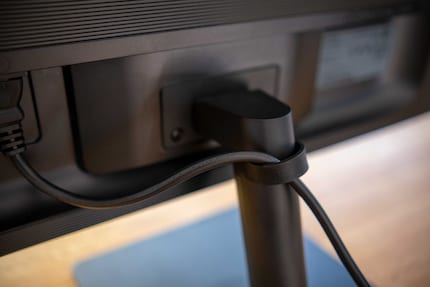
You can also connect remotely to your work device in the office. You obviously have to connect the keyboard and mouse. It’s not the fastest connection, but it’s fine for standard office tasks. The M5 and M7 also come with the Office 365 app, which lets you access your Office files in the Cloud without a PC.
Unfortunately, I wasn’t able to test out DeX as I don’t have a Samsung smartphone. But if my experience with Samsung’s ecosystem is anything to go by, it should work well. After all, Samsung is sort of like the Apple of the Android world – if you’re comfortable with the ecosystem, it’ll work for you.
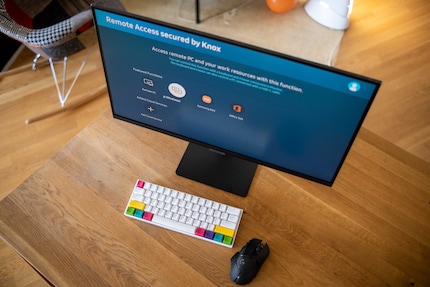
Thanks to all these connection options, you can operate the M5 and M7 smart monitors without a PC or notebook. If you’re a tech nerd like me, that might not be a decisive factor, although it can be for a lot of other people, as it lets you connect work and home life in the best possible way.
I mean, you can obviously still achieve that by hooking up any old monitor to your PC or using a Chromecast. But then you’d still end up with an extra device. Whereas, with smart monitors, you've got everything integrated in one.
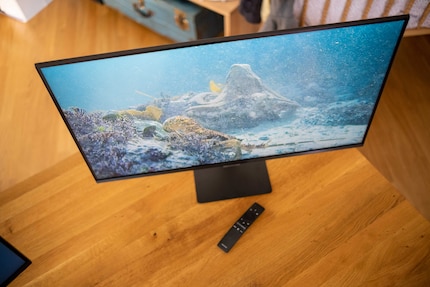
Sign of the times: monitors will probably have smart options more often
It goes without saying that no one wants to compromise any smart TV aspect of the device. The good news is, the remote control that comes with it lets you use the smart monitor and its Tizen operating system intuitively. There’s no need for any fiddly controls behind the monitor. Personally, I’ve never had a Samsung smart TV before, but I still got to grips with the system really quickly. The remote sits comfortably in your hand. In terms of controls, Samsung focusses on the essentials and treats us to three dedicated media buttons. There’s also the efficient voice control option that’s activated by pressing the relevant button. That’s something I enjoy using in the comfort of my own home.
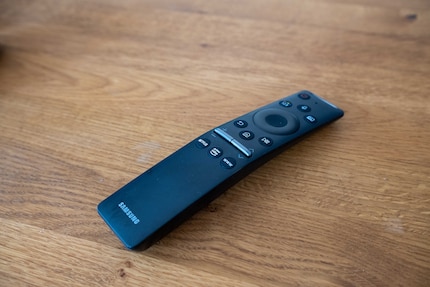
In the image settings, there are the usual presets to choose from, such as standard, natural, movie or dynamic. Things like brightness and contrast are adjusted separately. And there’s an equaliser to control the sound. Other features, such as ambient light, adjust the brightness automatically according to the surroundings. You can switch off this mode and set it to a minimum value. Energy-saving settings are also available and are even praiseworthy, including accessibility features such as voice guidance, high contrast or magnification of controls.
The built-in speakers are fine and on a par with other smart TVs. In other words, you’ll be looking for bass and volume controls to no avail. Fortunately, one of the HDMI ports features ARC, which lets you use a soundbar.
Display quality
When it comes to watching TV, I like the image quality on the M5 and M7. Although I do prefer the M7 as it boasts 2160p-resolution. I didn’t detect any anomalies with either of the monitors when I did the EIZO monitor test.
I used the x-rite i1 Display Pro to measure the monitors.
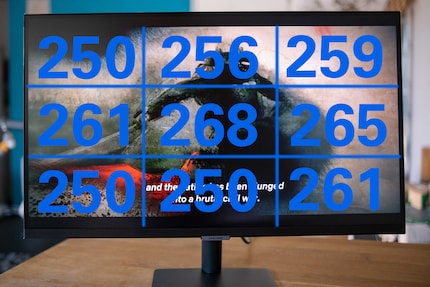
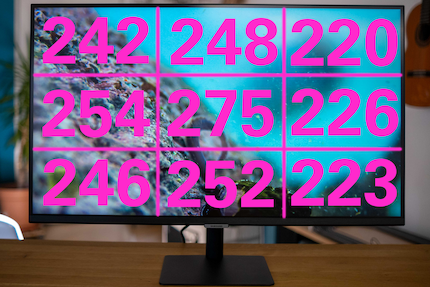
When it comes to checking brightness, both monitors reach the 250 nits specified, and they even exceed it in some cases. Illumination on the M5 is incredibly uniform. There’s at most 18 nits or 7% difference. With the M7, the difference is no more than 55 nits or 25%. I put the varying percentages down to the fact the M7 panel is bigger. It uses the same backlight as the M5, but it can’t achieve the same uniformity on the larger panel. To the naked eye, you can only spot a slight difference on a white background when the brightness is set to maximum.
Based on static contrast, the M5 panel fares well. The contrast is 3620:1, while Samsung’s official spec is 3000:1. It’s not as good a result with the M7. I record 3105:1. But in both cases, the figure is better than Samsung’s promised 3000:1. What’s pleasing in both monitors is that backlight bleeding is minimal.
When we come to colour space coverage, it doesn’t look as good for the M5 or the M7.
M5
- 96.7% sRGB.
- 71.5% Adobe RGB.
- 74.7% DCI P3
M7
- 93.4% sRGB.
- 67.2% Adobe RGB
- 69.8% DCI P3
For standard office-related work, these values are ample. But if you're doing any serious image or video editing, the Adobe RGB and DCI P3 values won’t cut it. You’d need to be looking at percentages above 90. But as we’ve already discussed, these monitors are designed for a home office.
I’ve obviously already used the monitors for some gaming, even though they’re not built with that in mind. Screen tearing isn’t much of an issue on the M5 and M7 like it is on the Eizo monitor, which my colleague Martin Jud put to the test recently. What bothers me a lot more on the M5 and M7 is the juddery image as a result of the 60 Hz refresh rate. At certain points, the monitors also have issues with ghosting. But you can still game quite happily on them using a PS4.
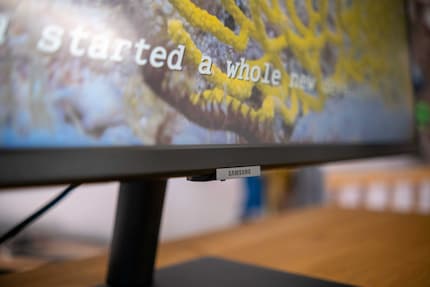
Shaky stand
Looks-wise, the smart monitors are like your average office monitor: plain casing on an inconspicuous stand. The monitors are almost bezel-less. When they’re switched off, the edges at the top and sides are only about 3 mm. Once you switch the monitors on, you get another 5 mm blacked out at the edge.
While the plain, metal stand ensures the monitors don’t tip over, it does make both the M5 and M7 shake a fair bit. It’s a good thing we don’t get big earthquakes in Switzerland.
From an ergonomics point of view, the M5 and M7 are more like smart TVs than monitors. You can only tilt them forwards or backwards. There’s no option to adjust the height or swivel them.
Verdict: the M5 and M7 have carved out their niche
Armed with its new smart monitors, Samsung has managed to fill a gap in the market created by Covid. Namely by providing monitors that also serve as TVs and don’t break the bank. Two for the price of one in your home office, so to speak. For the price tag, both monitors deliver good quality and an extensive range of features. A deciding factor is likely to be the different connection options, such as remote access or being able to use Office 365 without a PC. In short, these monitors are great for people who don’t necessarily want the best product on the market but who want something that can still let them be productive. Or to put it in nastier terms: your typical pen pusher.
For gamers or people who need greater image quality, neither the M5 or M7 deliver the goods. Similarly, these smart monitors probably aren’t for people who already have a separate monitor and TV.
So, why should you choose the M5 or M7 over a TV as a monitor? Thanks to their ports and image quality, smart monitors have more to offer than a comparable TV in the same price range. And what’s wrong with just using a monitor as a TV? You’d need to either use an additional device, such as a Chromecast or a PC/notebook.
I’m sure there's a market for the M5 and M7. But for those of us with slightly greater requirements, it would be great to see another more expensive model released with improved image quality and a higher refresh rate.
From big data to big brother, Cyborgs to Sci-Fi. All aspects of technology and society fascinate me.





